‘It affects all of us’: Larimer County CCAP enrollment expected to remain on a freeze
As a paraprofessional at a local high school, Belen Hernandez helps students from other countries learn English so that they can graduate high school.
Before she gets there each day, she drops her daughter off at child care — something Hernandez said was much more difficult before she enrolled in the Colorado Child Care Assistance Program, known as CCAP or CCCAP, last year.
“I’ve seen how much people that don’t have CCAP spend," Hernandez told the Coloradoan during an interview conducted in Spanish with reporter Ignacio Calderon. "If I had to spend that much money, I don’t think I could pay my bills. I’d be check after check after check."
On Feb. 5, Larimer County announced an enrollment freeze for the child care assistance program within the county, citing insufficient funding in a news release at the time. CCAP is a statewide program that provides child care services to families that are “homeless, working, searching for work or in school,” according to the state’s website.
While the freeze won't impact Hernandez and others currently enrolled in the program, it will keep new parents from enrolling — with some exceptions made for families in child welfare or the Colorado Works program — and is expected to continue into the next fiscal year.
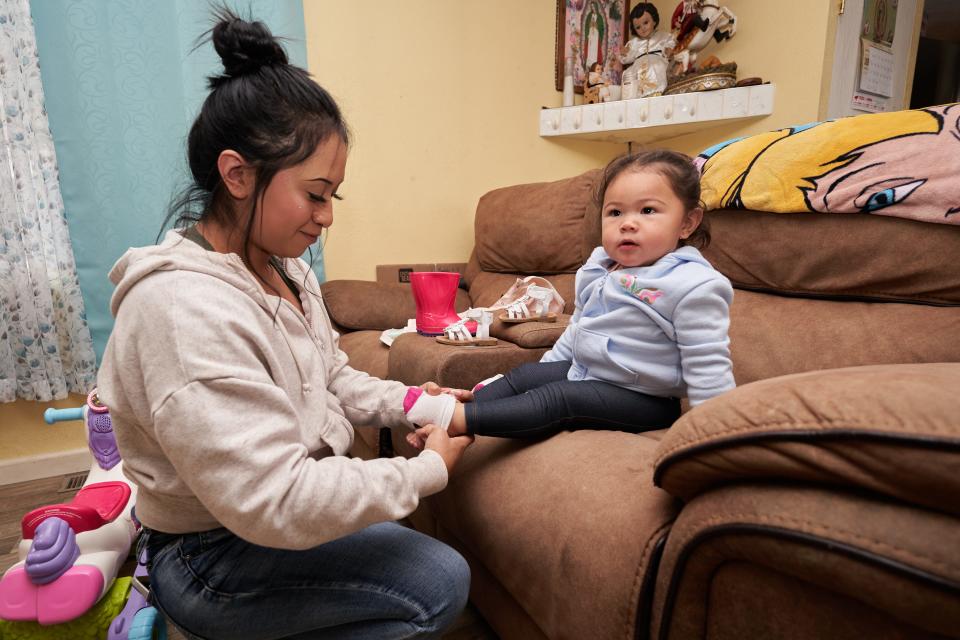
The Coloradoan requested financial documents and other information from Larimer County’s Human Services Department and talked to sources from several counties and the state to better understand Larimer County's decision to freeze the program. The Coloradoan requested interviews with Larimer County staff, who instead provided some responses via email before telling the Coloradoan to file an open records request for additional information.
Behind the financials Larimer County says led to the freeze
Leading up to the early February announcement, the Colorado Department of Early Childhood met with Larimer County “to discuss options that could be considered prior to the county implementing" the freeze, said Ian McKenzie, a public information officer with the state department.
Some of the options discussed were reducing the number of paid absences and transferring unspent funds from the county’s federal Temporary Assistance for Needy Families, or TANF, allocation to its child care allocation. Colorado Works is the state's TANF program.
“Importantly, counties significantly underspent the CCCAP stimulus allocation this fiscal year. … When allocations are underspent, counties do not need to go on a freeze” McKenzie told the Coloradoan by email.
At the end of each fiscal year, any unused funds are distributed to the counties that spent over their budget.
For example, last fiscal year, 10 of 64 counties in the state spent more than their CCAP budget. But at the end of the redistribution process, all counties with an over expenditure were covered.
Larimer County was not one of the counties that overspent. At the end of the past fiscal year, it had nearly $390,000 left from their allocation. However, this fiscal year the county was expecting to go over by $800,000 at the time of the freeze announcement.
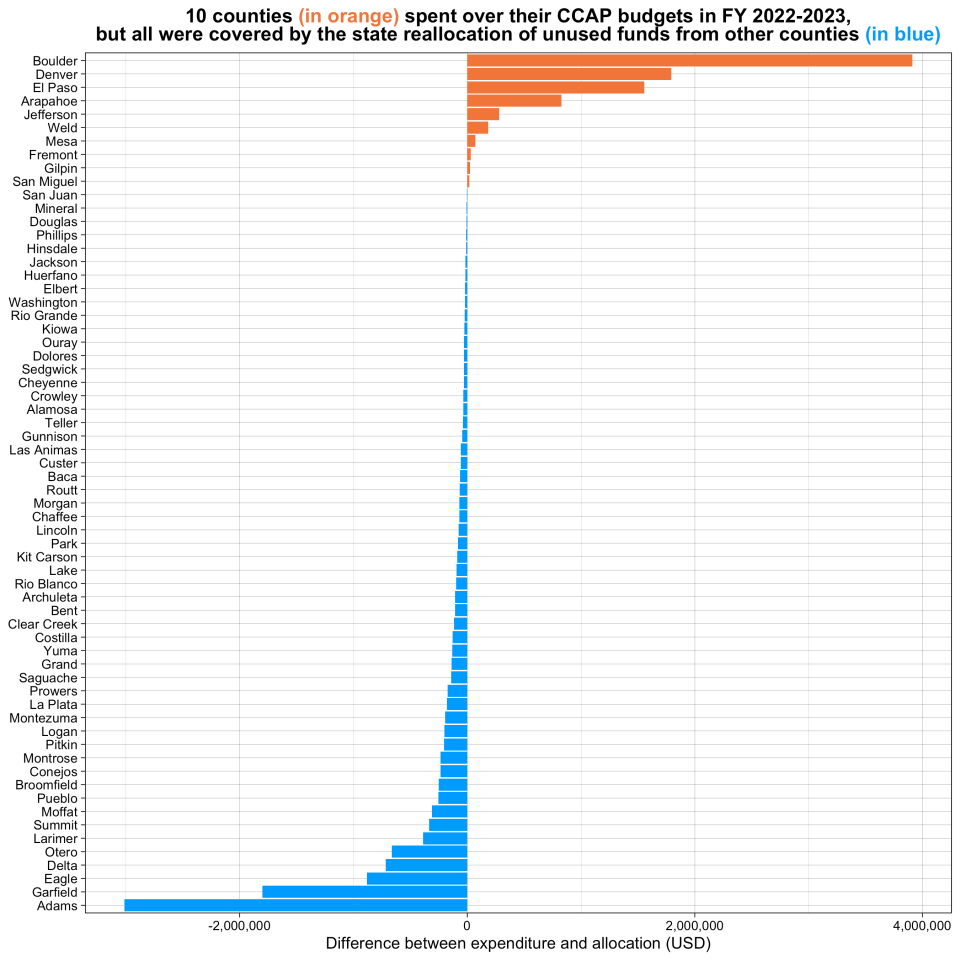
As of April 12, McKenzie said the state projects there’s enough funding to cover Larimer’s anticipated over expenditure.
However, “if a county doesn’t want to take the risk … they’re fully in their rights to implement a freeze,” he said.
Larimer County spokesperson Jill Maasch said in an email to the Coloradoan that the county "has not received anything in writing with a commitment of additional funding from the state and is unable to administer programs and budgets based on verbal assurances."
In Larimer County, the number of children served in open cases for CCAP in the fourth quarter of 2022 was 694. This increased by 40% — to 974 — in the fourth quarter of 2023.
"Unfortunately, Larimer County is seeing unprecedented need among families in our community and our state and federal allocations have not caught up to the need accordingly," Maasch said.
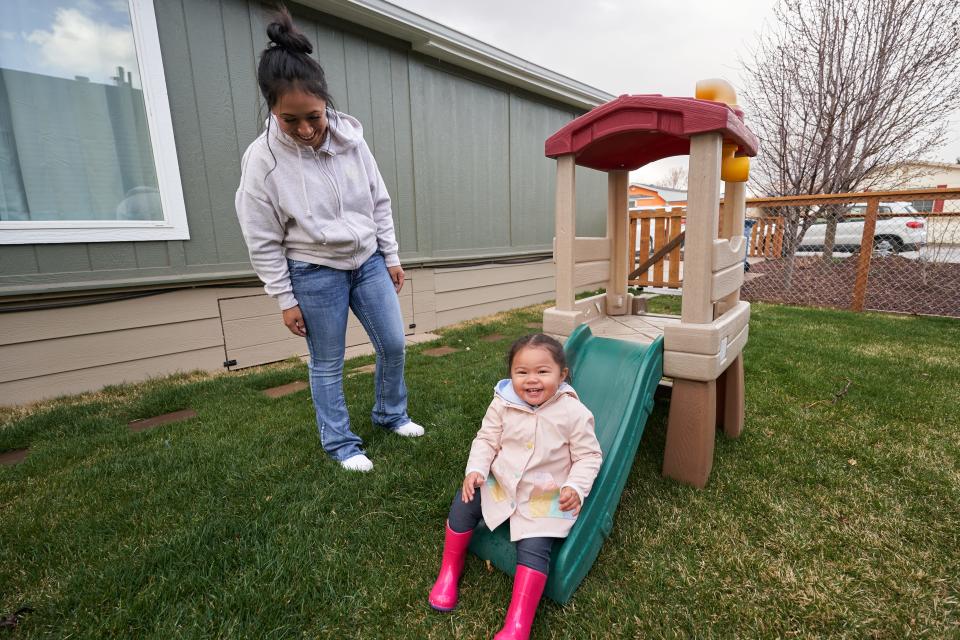
Since 2021, Larimer County has been relying on $1.7 million annually from emergency federal funds through the American Rescue Plan Act, which the county Department of Human Services said will end this fiscal year. That, combined with the county’s anticipation to overspend on CCAP, led them to freeze CCAP enrollment.
“Statute and Colorado Department of Early Childhood (CDEC) program rules do not give us the ability to prepare for a transition like this. We do not have the ability or flexibility to prepare for this,” Maasch said.
When asked about some of the alternatives proposed by the state early childhood department, Maasch said, “we have not made changes to these local policies because it would result in either shifting the cost back to the parents or impacting providers by reducing the payment for absences.”
As for the county’s TANF reserves, Maasch said the county would likely deplete them this year.
Last fiscal year, 26 out of the 64 counties went over their budgets for TANF, which the state allocates through Colorado Works. This included Larimer County, which had to use $921,378.70 from its TANF reserves, leaving the county with just shy of $2 million.
Although that would be enough to cover the projected CCAP over expenditure for this year, the county is also in the red for Colorado Works and Child Welfare Block. The three programs' overages combined would exceed $3 million.
“TANF, child welfare, and CCAP programs are required to be covered by TANF reserves, if Larimer County is not covered by the state at the end of each fiscal year,” Maasch said.
More: Need child care assistance? Your guide to applying for and renewing CCAP in Larimer County
How other Colorado counties have handled similar situations
Among the counties that surpassed their CCAP budgets last fiscal year were Arapahoe, Boulder and El Paso — all of which were covered by the state's reallocation process.
“We did not freeze enrollment because we knew that ARPA/state reallocation funds were available to cover over expenditure,” said Anders Nelson, Arapahoe County’s public information officer, in an email.
For this year, Nelson said the county anticipates overspending the regular allocation by around $1.1 million.
“Arapahoe County constantly monitors the caseload and allocation each month and has determined that adequate funding exists without needing to make any adjustments to the administration program, at this time,” Nelson said.
On March 1, Boulder County went on an enrollment freeze.
“It’s important to note, these programs expanded to meet increased demands during the pandemic — and generally, that demand remains,” Susan Caskey, director of Boulder County’s Housing and Human Services, said in an email.
Caskey said counties are now spending at higher rates that can reduce or eliminate the excess redistribution option.
“CCAP is a complex program and predicting the waitlist duration is difficult. Natural attrition is the only way children exit the program, so the ability to decrease spending is slow,” Caskey said.
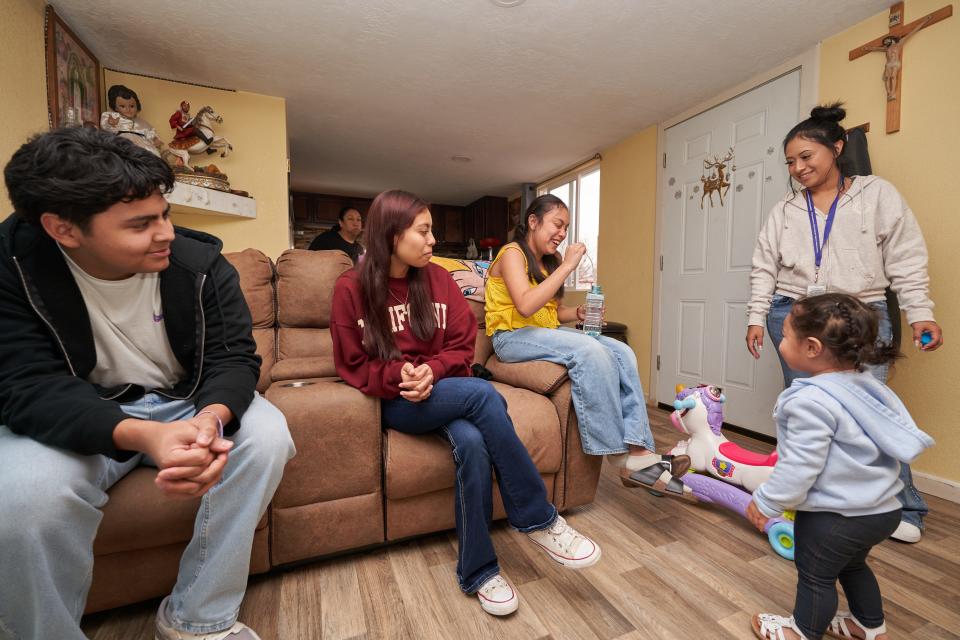
In the beginning of 2018, El Paso implemented a waitlist for the remainder of that fiscal year.
“At that point in time, we had spent about three years finding ways to save costs and fill the expected gap, so we put off putting a waitlist for as long as possible,” Kristina Iodice, the public information officer, said in an interview.
On a waitlist, a county still processes applications and as spaces open up, they enroll families in the program. On a freeze, a county completely stops enrollment, said El Paso County Human Services Deputy Executive Director Andrew Bunn.
Since the 2018 waitlist, El Paso County hasn’t had to implement either measure for the program. Because affordable child care supports self-sufficiency, Bunn said, they try to avoid interruptions to the program whenever possible.
“It really supports employment, which ultimately supports stability for families and all those social determinants of health that are tied into that,” Bunn said.
“Our plan for the last few years was to use our TANF reserves to cover any of those shortfalls, if they existed,” Bunn said. “So, we moved into close-out at the end of last year knowing we had overspent, knowing we had TANF reserves to cover that if we didn’t get covered through the surplus distribution.”
Child care ‘affects all of us,' provider says
When Gloria Kat, the executive director at The Family Center/La Familia, heard about the enrollment freeze on the news, her first concern was the families that depend on the program. Currently, the center has 54 children enrolled.
“We’re talking about families that are giving back to the community,” Kat said.
After working in special education, Hernandez decided to switch gears and make use of her bilingual skills. In a classroom of about two dozen, she walked back and forth on a recent Thursday morning, answering questions about a science assignment on eclipses. After her shift was over, she picked up her daughter and spent the evening with the rest of their family making hot dogs for dinner.
In the months before being accepted on CCAP, Hernandez said, she struggled to find work and someone to take care of her daughter.
She chose The Family Center/La Familia because of her connection to the place. As a kid, her parents used to take her to the center when it first opened up. Eventually, both of her younger sisters also attended the same child care.
“I wanted my daughter to be here because I know the people that work here. … I have a relationship with them, so I trust them,” Hernandez said.
“It means a lot for families to know that their children are in safe, qualified child care while they’re working,” Iodice, from El Paso County, said. “It’s hard to work if you’re really worried about your kid.”
Beyond child care, the center gives people a sense of community through different activities for those who don’t have a family nearby, Hernandez said, and they can help people find resources for things like school supplies or food.
“I know they really supported me this past Christmas to find gifts (for my daughter) since I was still struggling financially,” she said.
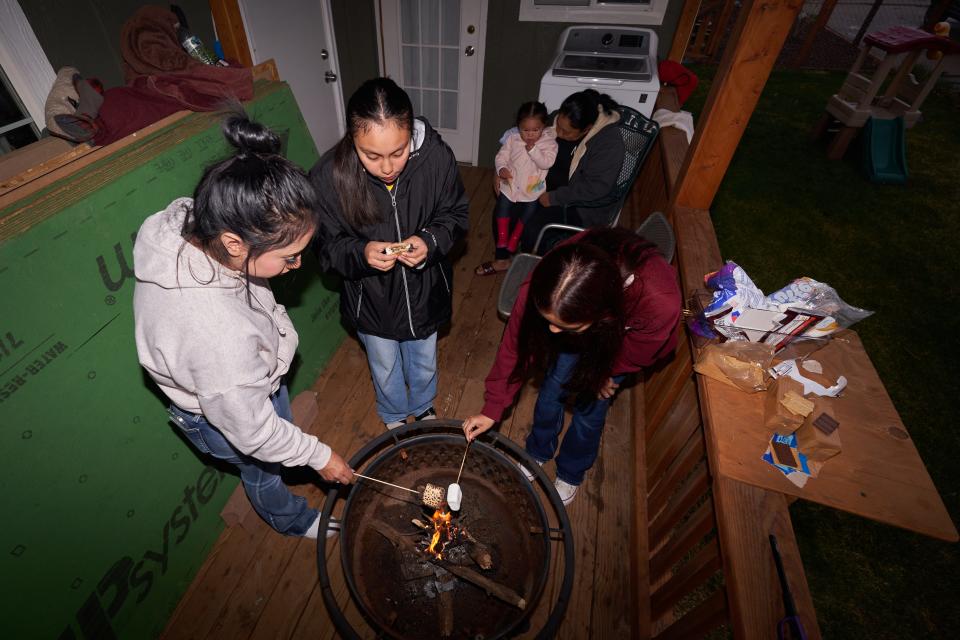
Kat said about two-thirds of the center's staff is bilingual, “so we have a great advantage in terms of cultural approach to the Latino/Latinx community and migrant community as well.”
She said 80% of the center's families rely on some sort of financial assistance. And although the impacts of the freeze might not be felt immediately, it could put parents in a bad situation in the longer term, Kat said.
According to the county announcement in February, current families will remain on the program if they continue to meet eligibility criteria, and “exceptions are made for families in child welfare or the Colorado Works program.”
But families that are in the program have to renew every 12 months, and if a parent misses their deadline, “they are going to have to choose to either stay at the center and pay without CCAP subsidy or go to the district,” Kat said.
Without assistance, average tuition for full-day care at The Family Center is around $1,600 per month, with rates varying depending on a child's age and how many hours they attend per day. And while district centers have the same curriculum, for parents that have multiple children, driving to multiple places can become a challenge.
Kat said the center's location is also strategic for the families who are living in the north part of town.
“Really close to us we have Hickory Village and then further north we have the Poudre Valley mobile home park,” she said.
As of April 5, Maasch said Larimer County's budget for the next fiscal year has not been formally approved yet. “However, what we anticipate is that we will see a decrease in total funding (base allocation and ARPA funds combined) and we will very likely remain on an enrollment freeze in SFY24-25.”
This doesn’t just affect families with children, Kat said. “If you’re a business owner or an employer and your staff relies on affordable child care, then it also affects you — it affects all of us.”
For more information on how to stay enrolled in the program and other questions, click here.
Ignacio Calderon covers climate and Larimer County government for the Coloradoan. Contact him at ignacio@coloradoan.com.
This article originally appeared on Fort Collins Coloradoan: Larimer County CCAP enrollment expected to remain on a freeze

